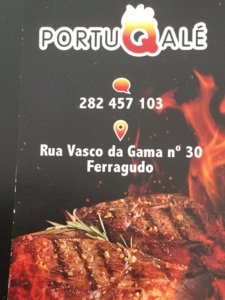Newsletter April 2021
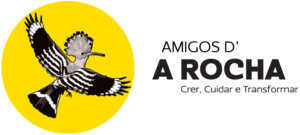
 Welcome to our April Newsletter 2021
Welcome to our April Newsletter 2021
Thank you for supporting.
Enjoy this month’s articles.
Happy and Sweet Easter
Helen & Filipa
S
N
A
P
SHOT

Portimão

Age: 551 BC
Town (since 1924)
Population: 55 614 (Census 2011)
Area: 182,06 Km2
Portimão is the largest city in the western Algarve, within the Faro District; it is limited by Monchique in the North, by Silves and Lagoa in the East, by Lagos in the West and by the Atlantic Ocean in the South. Portimão is the capital of the county and is divided into 3 parishes: Portimão, Alvor and Mexilhoeira Grande; it is located by the riverside of the River Arade.
Some doubts remain about the establishment of the city of Portimão, some authors mention that the city was founded in 551 BC by the Carthaginians and named “Portus Annibalis” (Hannibal’s Port) and 200 years later was conquered by the Romans, who kept the same name. Although the exact location of Portus Annibalis is not certain, there are several Neolitic and Roman archaeological trace elements within the area, but none in the exact location of the actual city. One thing is for sure, the Arade River was an important commercial route since the Roman period, and after, in 715, during the Moorish occupation, Portimão village was an important and dynamic commercial point, mainly due to the salt exploration and the drying of fruits, particularly figs.
In 1290, the area of Portimão was taken from the Moors and on the 8th August of 1463, the King of Portugal, Afonso V, gave permission and autonomy for a group of locals to develop a small village, named São Lourenço da Barrosa, with some independence from the main city (Silves at the time). Due to the location and the quick economic development, in 1476 it was elevated to village status and named Vila Nova de Portimão.
Between the XVII and XVIII Centuries, Vila Nova de Portimão, there were periods of poverty and hunger and many people abandoned the region; the city was also partly destroyed by the big earthquake in 1755. In the end of the XIX Century, Portimão was an important fishing port and had a big industrial development with the canned fish industry; in 1924, on the 11th of December was elevated to a town by the then President of Portugal, locally born, Manuel Teixeira Gomes.
Portimão, at the present time, is mainly a touristic and commercial centre, with plenty of nautical sports activities, it is worth discovering some of its beauties including the Arade river trips.
IFO’s – Identified Flying Objects…

Spanish Marbled White
(Melanargia ines, Hoffmannsegg, 1804)


Morphology: It is a medium butterfly from the Nymphalidae Family, with a wingspan between 45 to 55 mm. The wings have rounded edges, the upper side of the wings have white background and black ribs, the underside is cream coloured with dark ribs; the hindwings have blue costal ocelli (small eyes) encircled by reddish and yellowish coloration. One generation per year, it flies from March to June.
Habitat: Hot, dry, grassy hillsides with patchy scrub, rocky places with sparse grasses, cultivated lands and farmlands.
Distribution: Endemic to the Iberian Peninsula and North Africa.
Notes: The larvae feed on grasses of the Poaceae Family; the young larvae estivate and develop from autumn to spring. The species is locally common. The population is decreasing due to the expansion and intensification of agriculture. Very similar to Western Marbled White (Melanargia occitanica) which have brown and thick ribs on their underside.
Tweet… Tweet…


Common Sandpiper
(Actitis hypoleucos, Linnaeus, 1758)

Identification: It’s a small wader from the Scolopacidae Family, reaching up to 20 cm of length. The head, breast, back, and wings are brownish; the belly is white and the line of division between the two colours is well marked. On both sides of the neck the plumage creates a white band characteristic of the species. The bill is long and dark; the legs are short and dark greenish. It usually shows a whitish orbital ring. Males and females are alike.
Habitat and Ecology: Inhabits all kinds of wetlands, freshwater, brackish and salt water, like rivers, marshlands, streams, dams, estuaries, salt pans, and inter tide rocky coasts. The nest is a small depression in the ground close to bushes. The diet consists of insects (adults and larvae), spiders, molluscs, snails, crustaceans, worms and plant material. It has a restless behaviour, constantly wagging its tail.
Distribution: It breeds across Europe, East Asia to Japan; winters in Western Europe, Africa, Southern Asia and Australia. In Portugal it is present all year, in spring/summer it is more common inland, and in winter it is more commonly found close to the coast.
Threats: Least Concern (LC) in the International Union for Conservation of Nature (IUCN) red list. The population trend appears to be decreasing mainly due to habitat disturbance and habitat destruction.
DID YOU KNOW? 
-
Spring birds are here! March is always the month when the most part of the bird’s arrivals happen. Summer visit birds seen in March at Ria de Alvor: Common Quail (Coturnix coturnix), Yellow Wagtail (Motacilla flava), Sand Martin (Riparia riparia), Woodchat Shrike (Lanius senator), European Bee-eater (Merops apiaster), Common Swift (Apus apus), Tree Pipit (Anthus trivialis), Greater Short-toed Lark (Calandrella brachydactyla) and Gull-billed Turn (Gelochelidon nilotica).
- March at our ringing centre was calm, the number of birds has decreased, common at this time of the year, once birds are very busy breeding! The most interesting catch were European Green Woodpecker (Picus veridis), Siskin (Carduelis spinus), Western Subalpine Warbler (Curruca iberiae) and the first juvenile of the season a baby Wren (Troglodytes troglodytes)!
-
This month our centre is reopening (22nd of April)! We were closed for two and half long months but now we can welcome you back! Check here the website for more information and for booking your visit.

European Green Woodpecker (Picus veridis)

Western Subalpine Warbler (Curruca iberiae)
-
Jasper and Tayler, the new directors of the centre are doing an excellent job in the garden! The vegetables are growing, and wildlife is around! Visit the blogspot “Environmental Education in A Rocha” here to see Spring in Cruzinha garden!
- The ringing report of 2020 is now available on A Rocha website. Click here for the full report.


Spring is a beautiful time! Walking around in nature it is possible to see the fields “painted” with beautiful colours: yellow, pink, and purple! One of the most amazing flowers are the orchids! When we think about orchids, probably we think about the tropical orchids! Huge with lovely flowers! In the Algarve we also have orchids, wild orchids, some are small and maybe go unnoticed; it is necessary to keep a watchful eye to find them! Some are quite large with attractive colours and it is hard not to notice them! On my walks around the countryside in Mexilhoeira Grande, I managed to find some lovely species! One of the first ones to bloom is the Sombre Bee orchid (Ophrys fusca), it doesn’t have very attractive colours although the flowers are very variable, and it is hard to identify. The most common ones are the Mirror Orchid (Ophrys speculum), with a lovely blue/purple metallic colour, the Bumblebee Orchid (Ophrys bombyliflora), not so attractive in colour and size but with an interesting “design” and the Yellow Bee Orchid (Ophrys lutea) with a lovely intense yellow! One of the largest is the Pyramidal Orchid (Anacamptis pyramidalis), with a beautiful pinkish colour growing sometimes on roadsides! Always it is worth taking a closer look at the plants we can find around here, we never know if we can find a wild orchid! Enjoy your nature walks ☺
Filipa

Sombre Bee orchid (Ophrys fusca)

Bumblebee Orchid (Ophrys bombyliflora)

Mirror Orchid (Ophrys speculum)

Yellow Bee Orchid (Ophrys lutea)

Pyramidal Orchid (Anacamptis pyramidalis)
INVASIVE SPECIES 
Pampas Grass (Cortaderia selloana, (Schult. & Schult.f.) Asch. & Graebn)
Clade: Angiosperms, Monocots
Family: Poaceae
Origin: Tropical South America (Chile and Argentina)
Height: up to 2.5 metres
The Pampas Grass is a robust perennial grass with large whitish-silver plumes; it grows in a rosette with basal leaves; the leaves are greyish or bluish green, linear with razor sharp margins. The flowers are arranged in panicles (similar to large plumes) which grow on top of culms. The fruits are very small caryopses; they flower from August to October. Some plants produce hermaphrodite flowers and others only female flowers, it is a gynodioecious species.
 In its native range, Pampas Grass grows in moist soils in grasslands, dunes, open shrub lands and river sides. Named after the Southern America grasslands, known as the pampas, from where it is native. This plant was introduced in temperate and subtropical areas for ornamental use, for erosion control, and as a barrier or windbreak.
In its native range, Pampas Grass grows in moist soils in grasslands, dunes, open shrub lands and river sides. Named after the Southern America grasslands, known as the pampas, from where it is native. This plant was introduced in temperate and subtropical areas for ornamental use, for erosion control, and as a barrier or windbreak.
One of the characteristics of Pampas Grass which aids it’s invasion are the amount of seeds produced by female flowers. They can produce up to one million, which are easily dispersed by wind and can originate invasion in distant areas. The plant also forms dense and impenetrable tuffs that can damage grasslands and can affect visibility on roads, increases density and can colonize new habitats in short periods of time, creating a threat to native plants. Due to its low decomposition it can increase fire risk. Another problem related to invasive species is public health; the sharp leaves of the Pampas Grass can cause superficial cuts, its Latin name “Cortaderia” derives from a Spanish word which means “cutter”; the flowers can also cause allergies.
The project Life + Stop Cortaderia (2018-2022), aims to implement a transnational strategy to fight against the Pampas Grass in the Atlantic Arc (central and northern Portugal, northern Spain and France); for this purpose it is important to track and quantify the distribution of Pampas Grass and raise awareness of its harmful effect in local biodiversity. For more information visit the web site: Stop Cortaderia.
POPPED UP

Family: Cistaceae
Identification: It is a perennial dense shrub, growing up to 1 metre in size. The stem is branched all covered with short and soft hairs. The leaves are small, oval to elliptical, rough, hairy, dark green with a slightly toothed margin. The flowers are white and yellow at the base; the fruit is a five valved capsule. It flowers from March to July.
Habitat and distribution: Shrub lands, scrublands, sandy places, rocky places, pine woodlands, oak tree woodlands and abandoned lands. It occurs around the Mediterranean Region and Macaronesia. In Portugal it is present all over the country except for the highlands of north and centre.
Notes: This species tolerates drought well and a climate with maritime influence. The flowers are very attractive to the bees. It is often used to prevent soil erosion and for ornamental use in Mediterranean gardens and is also used in folk medicine (leaves or flowers) for urinary infections, kidney problems and diabetes.

Sage-leaved Cistus (Cistus salviifolius, L.)

DATES TO REMEMBER

1st, 8th, 15th, 22nd and 29th April – Cruzinha Birdringing display & Moth Talk (10am to 12 am).Open on the 22nd April. Book here
2nd April – Good Friday (National Holiday)
4th April – Easter Sunday (Holiday)
25th of April – Freedom Day, April’s Revolution, Carnation Revolution (National Holiday)
Thank you for supporting the Friends of A Rocha Portugal

Dr Roy Rodrigues
Av. Do Brasil, Qta das Palmeiras, Lt P2, R/c A, 8500-299 Portimão
(+351) 282180683
royaldente@gmail.com

Sítio da Amoreira, Lote 12,
Alvor, 8500-045 Portimão
(+351) 282412562/ 925433047
www.transfair.com.pt
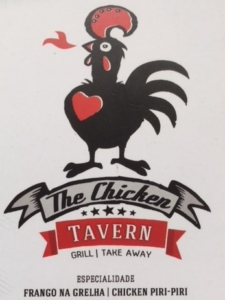
Urbanização Mar e Serra n° 47, Alvor
8500 – 783 Portimão
(+351) 911597735
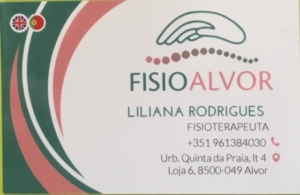
Physiotherapy, Massages (relaxation, sports, therapeutic)
Other therapies
Beauty (manicure, pedicure, hair removal, facials)
Open Monday to Friday
Thought of the month 
“Happiness is similar to freedom, because everyone talks about it and nobody enjoys it.” ― Camilo Castelo Branco (Portuguese writer, 1825-1890)

LETS BE GREEN – LETS BE GREEN – LETS BE GREEN 
Small things which make a difference!
General products
- Choose rechargeable batteries with 0% mercury and 0% cadmium
- Choose paints without lead (or natural/organic paints)
- Do not buy rare wooden or illegal furniture (like mahogany or teak)
- Do not buy illegal species of pets
- Choose recycled and recyclable products
- Choose products with less packaging
- Choose larger packets of products (usually they are more economic and reduce the amount of packaging used)
- Choose glass bottles instead of plastic or paper
LETS BE GREEN – LETS BE GREEN – LETS BE GREEN
Wildfire and Plant-pollinator networks
Fire is considered a natural phenomenon in some regions, like the Mediterranean, where it is an important process in the evolution of ecosystems. Fires are important for the survival of some animals and plants and they can even promote biodiversity under the right conditions. Plants and animals developed adaptations for the fire; some plants need fires to complete their life cycle (seed germination), others re-sprout easily after fire (Kermes oak), or develop a resistant bark (Cork Oak), and some animals colonize open areas created by fires (Ortolan Bunting). However, climate change and other social and economic features are increasing the number and severity of fires, now designated as wildfires. The impact of wildfires in ecosystems is still not fully understood as to how this can affect fauna and flora. 
Plant communities often increase floral abundance and diversity after fire, although one of the processes that is not well understood is how the wildfires affect the plant-pollinator interactions. Most plants rely on animal pollinators to produce seeds and fruits; together plants and pollinators develop a special bond and neither of them can live independently; plants need pollinators to reproduce and pollinators need plants from which to feed. Different kinds of animals can work as pollinators: mammals, bats, birds, and of course the most famous ones, insects (bees, beetles, flies, butterflies, and moths).
Researchers have shown for the first time the detrimental effect of wildfires on moths and the ecological benefits they provide by transporting pollen, making interacting plant and insect communities more vulnerable to local extinctions.
Paula Banza (see Newsletter June 2018), has been working for several years with moths and their role as plant pollinators. She did her PhD thesis under the title “Pollination Ecological Networks and Post-fire Recovery.” She investigated the effects of wildfire on nocturnal pollen-transport networks, analysing the abundance and diversity of moth species in both burned and unburned sites. Her results suggested that wildfires can have negative impacts on moth populations. Moth populations changed significantly in burned sites during the study period. Compared with flowers that were more abundant in burned sites, moths’ abundance and diversity were lower. Although, it is not possible to understand if this change is temporary and if the ecosystem can recover to a pre-burned stage. This study also evidenced the importance of moths as pollen vectors in the Mediterranean ecosystems, with 70% of the moths analysed carrying pollen. Flowers were more abundant in burned sites, but moth’s abundance and diversity was lower.
Further studies need to be done to better understand the impact of wildfires on pollination systems and to develop effective conservation management plans. Read the full article here
Sustainability Champions 
Sustainability Champions from around the World– Looking at ways to curb pollution and waste management.
We would like to thank Daniel Hartz, the founder of Sustainability Champions for giving us the permission to share this information.
Electric car – University of Technology, Eindhoven
The group of twenty-two students from the University of Technology in Eindhoven, the Netherlands created a fully functioning electric car made entirely out of waste, including plastic fished out of the sea, recycled PET bottles and household garbage(they collected Plastic bottles for almost two years) and after working 18 months on the project the result is a very sporty electric car, which is called Luca, that weighs only 360 kilos, has a top speed of 90 kilometres per hour and can cover up to 200 kilometres in a single charge. 
Luca is a really special car because it is made entirely from waste, with its chassis made of recycled PET bottles and flax (PET is polyester which has a chemical name of polyethylene terephthalate, it’s a plastic resin and is the most commonly used plastic material for packaging). Its interior is made of unsorted household waste while its body is made out of recycled hard plastic found in televisions and kitchen appliances. Its seats and cushions are made of coconut waste and horse hair.
The students designed and built Luca to prove to, and to show the world the potential of using recycled material and waste.

Let’s stop House Martin nest destruction
Removing House Martin, Swallows and swift nests is illegal. If you know someone who wishes to do so, try explaining that these birds eat lots of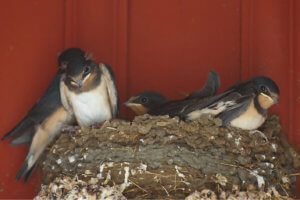 insects, especially the flies and mosquitoes which can ruin a pleasant summer night. If cleanliness is the issue, a simple solution is to install a ‘droppings shelf’ under the nests. If these arguments are not enough, or you only find out after the fact, please contact the authorities through ‘Linha SOS Ambiente’: 808 200 520 or www.gnr.pt/ambiente.aspx.
insects, especially the flies and mosquitoes which can ruin a pleasant summer night. If cleanliness is the issue, a simple solution is to install a ‘droppings shelf’ under the nests. If these arguments are not enough, or you only find out after the fact, please contact the authorities through ‘Linha SOS Ambiente’: 808 200 520 or www.gnr.pt/ambiente.aspx.
More info here
Photo by Stefan Berndtsson

Check the website for dates for organised tours
Rose-ringed Parakeet (Psittacula krameri)
The Rose-ringed Parakeet is a species present in tropical Africa and the south of Asia. It is a species which is often kept in captivity and used as a pet, and the European populations come from birds which have escaped or were released in the wild. It has been introduced in various countries in Europe such as England, Belgium, France, Italy, the Netherlands, Turkey, Spain and Portugal. It is usually found in big cities where they used to be sold and kept in captivity. Hence, in Spain, the most important populations are in Barcelona, Sevilla, and villages along the Mediterranean coast. In Portugal, it is present in the Lisbon area (where most of the population is) and in coastal areas with a high density of population such as Porto, Mira, Caldas da Rainha, Portimão and Lagos. It was also introduced in São Miguel in the Azores where it is rare and localised and recorded in Santa Maria. There were incidents of breeding in Madeira in 2009. 
In Spain, the oldest sighting was in Caceres in 1970. In Barcelona, the population has been present since 1980 and the first breeding there and in Malaga happened in the 80’s and in Valencia in the 90’s. In Portugal, the species was first recorded at the end of the 70’s.
In Spain, the species can appear anywhere but the breeding has been restricted to the Barcelona, Valencia, Alicante, Malaga, Sevilla and Madrid areas and in the Asturies. In Portugal, the species breeds mostly around Lisbon and also in Mira.
The Spanish Population was estimated to be between 213-254 pairs in 2003 but has increased since. In Catalonia, 80-100 birds were counted between 1999 and 2002. A new census between 2006 and 2009 registered 272-499 parakeets, which shows an annual increase of 17%. Studies in London showed that the species expanded 0.4 km/year over 12 years. In June 2013, a flock of about 300 birds was recorded in Sevilla. In Lisbon, a roost of 20-30 birds was counted in 1990 and there were 208 parakeets in this same roost in November 2003. The Portuguese population has been estimated at about 250 birds, most of them in the Lisbon area. There is no proof of regular breeding in the Algarve. A look at the data available on ebird shows that there are a few sparse sightings between Bensafrim and Tavira, mostly along the coast. At Ria de Alvor, the species was recorded for the 1st time in 2000 and then 2001 and 2002 when the maximum, only 2 birds, was seen. The species only reappered in 2007 and between 2010 and 2012 and in 2015. It has not been registered since.
 The species is resident in urban parks and gardens with big trees providing food and roosting places. The only movements registered in winter were to look for food so the breeding and wintering ranges are quite similar. The expansion of the species is limited by the presence of trees with holes where it can breed. That is why the Rose-ringed Parakeet has not spread as much as the Monk Parakeet (Myiopsitta monachus) which builds its own nest.
The species is resident in urban parks and gardens with big trees providing food and roosting places. The only movements registered in winter were to look for food so the breeding and wintering ranges are quite similar. The expansion of the species is limited by the presence of trees with holes where it can breed. That is why the Rose-ringed Parakeet has not spread as much as the Monk Parakeet (Myiopsitta monachus) which builds its own nest.
In 2020, SPEA organised a census of the species at roosts. The firsts results, without surprise, show that most of the birds are found in the Lisbon area. This census will be followed by another one at the end of 2021.
Photos and text by Guillaume Réthoré
If you have any queries please do not hesitate to contact us:
friends.arpt@arocha.org
Or visit us on our open day: Thursdays from 10:15 to 12:00 am
See map: https://arocha.pt/en/contact-us/
GPS coordinates
37°08’39.8″N (37.1444) 8°36’29.2″W (-8.6081)
(+351) 282 968 380
Thank you for supporting us!
Hope to see you soon!


